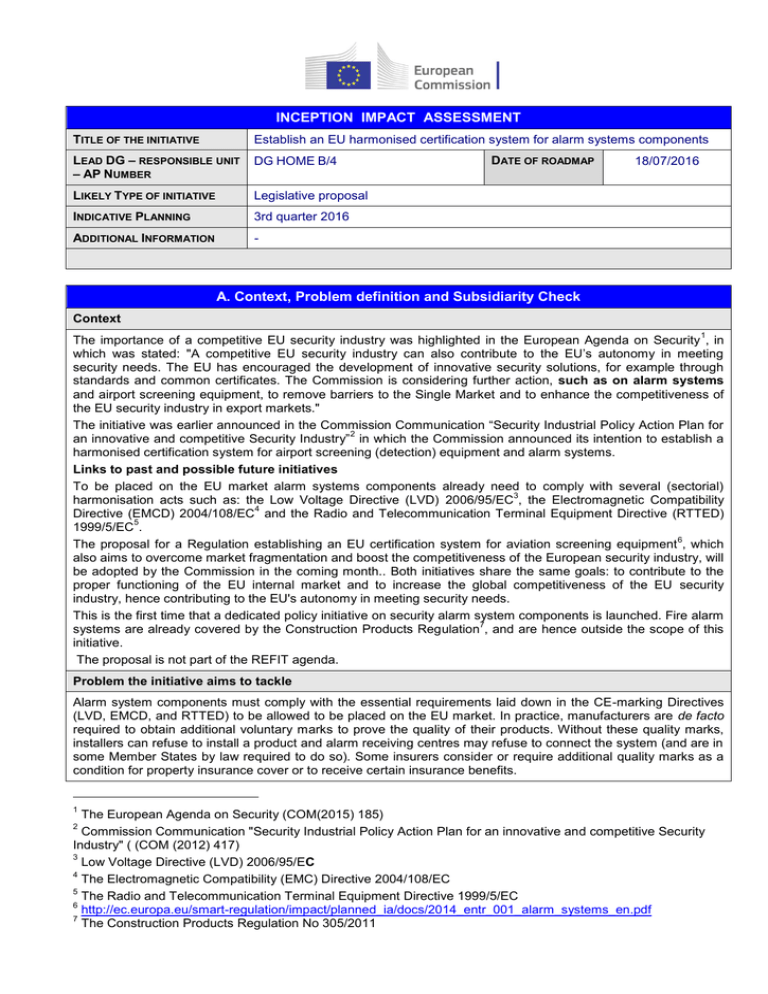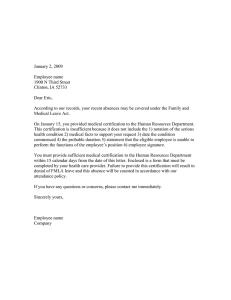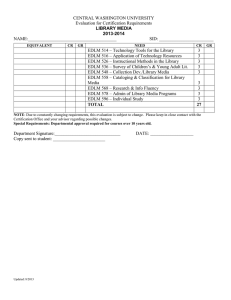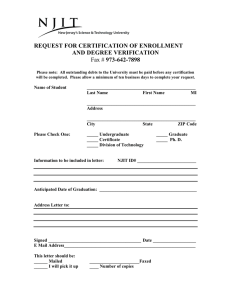Establish an EU harmonised certification system for alarm systems
advertisement

INCEPTION IMPACT ASSESSMENT TITLE OF THE INITIATIVE Establish an EU harmonised certification system for alarm systems components LEAD DG – RESPONSIBLE UNIT – AP NUMBER DG HOME B/4 LIKELY TYPE OF INITIATIVE Legislative proposal INDICATIVE PLANNING 3rd quarter 2016 ADDITIONAL INFORMATION - DATE OF ROADMAP 18/07/2016 A. Context, Problem definition and Subsidiarity Check Context 1 The importance of a competitive EU security industry was highlighted in the European Agenda on Security , in which was stated: "A competitive EU security industry can also contribute to the EU’s autonomy in meeting security needs. The EU has encouraged the development of innovative security solutions, for example through standards and common certificates. The Commission is considering further action, such as on alarm systems and airport screening equipment, to remove barriers to the Single Market and to enhance the competitiveness of the EU security industry in export markets." The initiative was earlier announced in the Commission Communication “Security Industrial Policy Action Plan for 2 an innovative and competitive Security Industry” in which the Commission announced its intention to establish a harmonised certification system for airport screening (detection) equipment and alarm systems. Links to past and possible future initiatives To be placed on the EU market alarm systems components already need to comply with several (sectorial) 3 harmonisation acts such as: the Low Voltage Directive (LVD) 2006/95/EC , the Electromagnetic Compatibility 4 Directive (EMCD) 2004/108/EC and the Radio and Telecommunication Terminal Equipment Directive (RTTED) 5 1999/5/EC . 6 The proposal for a Regulation establishing an EU certification system for aviation screening equipment , which also aims to overcome market fragmentation and boost the competitiveness of the European security industry, will be adopted by the Commission in the coming month.. Both initiatives share the same goals: to contribute to the proper functioning of the EU internal market and to increase the global competitiveness of the EU security industry, hence contributing to the EU's autonomy in meeting security needs. This is the first time that a dedicated policy initiative on security alarm system components is launched. Fire alarm 7 systems are already covered by the Construction Products Regulation , and are hence outside the scope of this initiative. The proposal is not part of the REFIT agenda. Problem the initiative aims to tackle Alarm system components must comply with the essential requirements laid down in the CE-marking Directives (LVD, EMCD, and RTTED) to be allowed to be placed on the EU market. In practice, manufacturers are de facto required to obtain additional voluntary marks to prove the quality of their products. Without these quality marks, installers can refuse to install a product and alarm receiving centres may refuse to connect the system (and are in some Member States by law required to do so). Some insurers consider or require additional quality marks as a condition for property insurance cover or to receive certain insurance benefits. 1 The European Agenda on Security (COM(2015) 185) Commission Communication "Security Industrial Policy Action Plan for an innovative and competitive Security Industry" ( (COM (2012) 417) 3 Low Voltage Directive (LVD) 2006/95/EC 4 The Electromagnetic Compatibility (EMC) Directive 2004/108/EC 5 The Radio and Telecommunication Terminal Equipment Directive 1999/5/EC 6 http://ec.europa.eu/smart-regulation/impact/planned_ia/docs/2014_entr_001_alarm_systems_en.pdf 7 The Construction Products Regulation No 305/2011 2 To obtain quality marks manufacturers apply for certification by certification bodies. These bodies request associated testing laboratories to perform the necessary tests to verify compliance with the relevant standards and the additional requirements (if any) and issue a report. If the results of the tests are satisfactory and all other requirements for certification (e.g. mandatory factory inspections) are met, the certification body issues an approval certificate and grants the manufacturer the use of its quality mark. In principle, the use of quality marks and approval certificates is not restricted to one Member State. In practice, however, manufacturers who market their products in more than one Member State need to obtain several quality marks, because there is no official mutual recognition. This forms a substantial barrier to the free movement of goods within the EU, and has a negative impact both in terms of time and costs. Problem driver The main driver of the problem described above is the fragmentation of national certification and approval processes. Currently producers of alarm systems seeking to market their products throughout the EU will typically need to apply for 10-15 different certificates. The costs of certification of an alarm system are on average (with a large spread depending on the nature of the product) at the level of €200.000-300.000 for full access to the EU 8 market. According to an external study performed in preparation of the impact assessment, the total costs for certification and conformity assessment of alarm system components are estimated to range between €6.2 million 9 and €13.2 million per year. Apart from the direct certification costs, the multiple certifications of alarm system components across Member States also add substantial costs in terms of adaptation. Due to the specific requirements that products must meet in order to obtain certain quality marks, manufacturers often have to adapt their products and produce different versions for different national markets. These modifications increase the development costs and make it more difficult to benefit from an economy of scale. Moreover, financial resources that are used for certification or the adaptation of products cannot be used to invest in research and innovation. Certification in its current form is not only a costly exercise; it is also a time-consuming process. Stakeholders have indicated that it typically takes 2-3 years to get all the necessary marks. Stakeholder mapping Various stakeholder groups are affected by this fragmentation of the internal market and the need for multiple certifications: Manufacturers: producers of alarm system components have to pay to obtain the different voluntary marks which increases their development and production costs. These costs are further increased when manufacturers need to modify their products in order to meet the requirements of the different quality marks. Particularly for SMEs, the high costs of certification and modification of products can be a serious problem. Consumers: the additional costs which manufacturers pay in order to acquire the different marks and to align their products to the national requirements are reflected in the price of the final products. Certification bodies: under the current framework (with the exception of the two initiatives led by Certalarm and the EFSG) each certification body awards its own quality mark, after it has been demonstrated that the product concerned meets the scheme's specific requirements (incl. potential national requirements). Generally (with the exception of Certalarm and the EFSG) certification bodies do not recognise each other's' test results. Certalarm and the EFSG (European Fire and Safety Group): these organisations are behind the two industry-led initiatives that aim to address the absence of an EU harmonised certification system. Testing laboratories: at the request of certification bodies testing labs test if products meet the requirements of the certification body concerned. Insurance companies: third-party certification is one element that insurers may take into consideration as a part of their risk assessment. Products certified by third parties (i.e. certification bodies) can provide a solid basis for risk transparency because the quality mark indicates compliance with technical standards and additional requirements. Subsidiarity check (and legal basis) The legal basis for EU action is Article 114 TFEU, which deals with the approximation of laws of the Member States in order to achieve the objectives of Article 26 TFEU, namely, the proper functioning of the internal market. In this area the Treaties have conferred on the Union a competence shared with the Member States. EFSG members (certification bodies) have produced a series of agreements that facilitate the acceptance of each other's testing, making it easier to obtain different marks. Certalarm provides a European scheme based on which fire and security products are tested and certified to obtain the Certalarm mark. However, the industry-led initiatives set up by Certalarm and the EFSG reduce the certification costs and time only partially,. Over the years, 8 9 Commission Staff Working Paper "Security Industrial Policy" SWD(2012) 233, p.95 Ibid, p.99. 2 in the absence of EU-level action, the situation has not improved as multiple certifications remain possible. It is highly unlikely that the situation will improve without EU action as the existing national barriers to the free movement of alarm systems components cannot be removed through Member States' unilateral actions. B. Objectives and Policy options The main policy objective of this initiative is to contribute to the proper functioning of the EU internal market and increase the competitiveness of the EU industry by simplifiying certification in the EU.. Option 1- "Baseline scenario": No EU action. In this scenario the Commission would not launch any dedicated policy initiative to address the lack of an internal market for alarm systems components. This would further aggravate the current internal market failure for alarm system components. Option 2 - Recommendation: The Commission would issue a Recommendation endorsing the existing industryled initiatives and encouraging Member States to take action and remove obstacles to the internal market by ensuring that voluntary marks issued by different certification bodies are mutually recognised. The 10 Recommendation would refer to the Mutual Recognition Regulation and the Commission interpretative communication on facilitating the access of products to the markets of other Member States: the practical 11 application of mutual recognition . Option 3 -Legislation–The Commission would prepare a legislative proposal in order to address the lack of an internal market for alarm systems components. Two different sub-options will be examined and evaluated in the impact assessment: Option 3a - The adoption of an EU act establishing a special "EU-Security Mark" – The Commission would prepare a legislative proposal establishing a special "EU-Security Mark" which indicates that a product meets certain security requirements. It would replace the existing national voluntary marks. The mark would be displayed alongside de CE-marking, which shows compliance with the existing CE-marking Directives (LVD, EMDC and RTTED. Member States would have to ensure that the provisions in the act are respected within their territories. Non-compliance with these rules may result in penalties. Option 3b - The adoption of an EU act on alarm system components (CE-marking)" – The Commission would prepare a new approach Directive/Regulation outlining the essential requirements which alarm systems components should meet in terms of security to be placed on the EU market. Products, regardless of their country of origin, may only be placed on the market if these essential requirements are met. Reference would be made to the existing European Standards developed by the European Standardisation Organisations, which would become harmonised standards. Additional (national) requirements would be abolished. Compliance with the harmonised standards gives products a presumption of conformity, but manufacturers may use other technical specifications if they can demonstrate that the essential requirements are met. The modules used to demonstrate conformity would be outlined in the act. Alarm systems components which conform to the essential requirements are marked with the CE-marking. Because the CE-marking is the only mark that may be used to demonstrate conformity with the essential requirements, there would not be room for additional voluntary marks. Member States would have to ensure that the provisions in the act are respected within their territories. Non-compliance with the rules on the CE-marking scheme may result in penalties. C. Preliminary Assessment of Expected Impacts Likely economic impacts Without (effective) action at the EU-level (baseline) the lack of an internal market for alarm systems components will deteriorate the position of the EU industry on the global market. Considering the inherent voluntary nature of a recommendation, there is a degree of uncertainty regarding its costs and benefits. The benefits of option 2 would depend on the willingness of the Member States to implement the recommendation. In a "best case scenario", where the Member States follow all the recommendations, the benefits could have a positive impact on the free movement of goods, as manufacturers would no longer need multiple certifications to commercialise their product across the EU. In terms of time to market, producers would be able to reduce the time needed to place their products on the market. In this case, the impacts would be largely identical to those of the legislative options. However, in a "worst case scenario", the Member States would not follow any of the recommendations of the Commission. In this case, the impact of this option would be largely identical to the baseline option, which would lead to a further deterioration of the current competitiveness of the EU manufacturers. . 10 Regulation (EC) No 764/2008 11 Commission interpretative communication on facilitating the access of products to the markets of other Member States: the practical application of mutual recognition (2003/C 265/02) 3 The two legislative options are expected to have a positive impact in terms of: Lower production and development costs for alarm systems components A significant reduction in adaptation/modification costs Increased sales opportunities due to a shorter time-to-market More benefits in terms of economies of scale Lower prices for consumers Likely social impacts By eliminating barriers to the freedom of movement, the initiative would contribute to the proper functioning of the EU internal market and increase the competitiveness of the EU industry. A more competitive EU security industry will be able to offer technological solutions which will actively increase the safety and security of EU citizens and will contribute to the capacity of the EU society to address security concerns. The adoption of a CE-marking act on alarm systems components or the creation of a compulsory EU Security-Mark certification scheme would have a stronger impact on security than a voluntary scheme. The increase in competitiveness expected as a result of options 3.a and 3.b should lead to an overall increase of sales of EU manufacturers in third countries. This increase of sales should in turn have a positive impact on the overall employment figures in the alarm systems manufacturing sector. It is not possible however to precisely quantify this impact considering that there are no definite indications on the overall employment figures in the sector. Likely environmental impacts None of the options outlined above would have a significant environmental impact. A reduction of the number of tests on alarm systems components might reduce testing laboratories' energy consumption. There are no concrete figures on the energy savings resulting from the reduction in the number of tests. Likely impacts on fundamental rights Fundamental rights should not be affected by the initiative. Likely impacts on simplification and/or administrative burden The two legislative options are expected to reduce the administrative burden of alarm systems components manufacturers. By ending the current practice of having to apply for multiple quality marks, manufacturers will only have to go once through the approval and certification process. This saves effort and time, and it also solves the problem of delays in the time to market. Stakeholders have indicated that this is important because being too late with a product means reduced sales. The fact that manufacturers will have one certificate in the EU member states leads to eliminate duplication of product testing. D. Data Collection and Better Regulation Instruments Impact assessment An impact assessment is being prepared to support the preparation of this initiative and to inform the Commission's decision. The work on this initiative started in October 2012. Data collection Work for the preparation of the initiative started in 2012. In order to have a comprehensive understanding of the EU security industry and the different sectors the Commission commissioned two studies: A study carried out by an external contractor in support of an earlier Impact Assessment in 2012 for the 2012 Security Industrial Policy Communication "Action Plan for an innovative and competitive Security Industry" entitled: "Regulatory Framework and Certification/Conformity Assessment Procedures in the 12 Security Sector' (referred to as SECERCA study). A study carried out by an external contractor in support of this Impact Assessment entitled “Study on 13 security R&D in major 3rd countries” (referred to as “SER3CO”). The study analysed in detail the certification and conformity assessment schemes in the EU and the world. It included also an assessment of the impacts of the policy options identified by the Commission. The Action Plan for an innovative and competitive Security Industry as well as the accompanying Commission 14 Staff Working Paper on the Security Industrial Policy included an extensive analysis of the EU alarm systems market. 12 ECORYS, Regulatory Framework and Certification/Conformity Assessment Procedures in the Security Sector, http://ec.europa.eu/enterprise/policies/security/documents/index_en.htm 13 ECORYS, Study on Civil Security R&D in major third countries (SER3CO), (Oct 2013), http://ec.europa.eu/enterprise/policies/security/documents/index_en.htm. 4 Consultation strategy In June 2013 a letter was sent to the permanent representations of all EU Member States in order to obtain more information about national requirements and certification schemes. An open Public Consultation on the certification of alarm systems components ran from 17 April 2013 to 10 July 2013. This consultation was published on Your Voice in Europe. Specific questions were asked on the size of the problem, the effects of the current state of play on the different stakeholder groups and, the likely impact of different policy options. The consultation received 171 contributions from eighteen different countries. All stakeholder groups (all types of enterprises/companies – small, medium, large and micro, national administrations, non-governmental organizations, business associations and individual citizens) were represented. The results of the public consultation have been uploaded to a website: http://ec.europa.eu/enterprise/policies/security/industrial-policy/consultation-on-alarm-systems/index_en.htm A workshop was organised as a follow up to the public consultation on 19 June 2014. The workshop was well attended and comprised representatives from all the stakeholder groups concerned. The aim of the workshop was to present the results of the public consultation and hear the views of the different stakeholders on the current situation. Even though time has elapsed between the public consultation, the workshop and the publication of this inception impact assessment, the findings from the consultations are still valid. This has been confirmed during bi- and multilateral discussions with stakeholders over recent months. These meetings were attended by representatives from insurance companies, manufacturers, certification bodies, testing labs and the two industry-led initiatives Certalarm and the EFSG. Will an Implementation plan be established? Every five years, the Commission will publish a general report on the implementation of the initiative. This report will be based on information provided by the Member States and data obtained via a targeted survey aimed at relevant stakeholders. The aim of the report is to assess the efficiency and effectiveness of the initiative's implementation with respect to the operational objectives. 14 Commission Staff Working Paper "Security Industrial Policy" SWD(2012) 233 5



